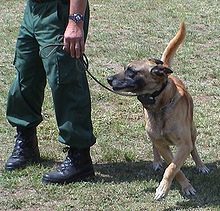 Love your dog, but also love your material possessions. Regrettably, your dog probably does not share the same appreciation and respect for material possessions of yours that you do, seeing everything instead as a chew toy. Read on to find out how to train your dog so your life can be less stressful.
Love your dog, but also love your material possessions. Regrettably, your dog probably does not share the same appreciation and respect for material possessions of yours that you do, seeing everything instead as a chew toy. Read on to find out how to train your dog so your life can be less stressful.
When crate training an indoor dog or puppy, you may try some tricks. A dog is naturally hesitant about a crate at first. A way to get them interested is to put their favorite toy in the crate, then shut the door. This will make the puppy want to be let inside the crate to get the bone. Once they go in the crate, praise them so that they know they did well.
It takes a while for a dog to get comfortable in a crate. Don’t take it too fast; introduce the dog at his own pace. After they become used to each individual step and do not mind going inside the crate, try shutting the door and giving them treats with the door closed.
In the beginning it is important to only leave the dog in the crate for a few seconds. After a while you will be able to leave them in the crate for longer amounts of time. If your puppy starts acting distressed about going into the create, you need to slow things down.
For the best results in training your pet, you must be diligent about giving rewards and encouragement. Treats, toys and praise have to be given in the right doses and at the correct times. If you do not give the treat right away, your dog is not going to understand why you are rewarding it.
Verbal cues are very important to make sure that your dog is under your command. If you do not have a treat you can reward your dog with, pet it and talk to it in a soft voice until you find a treat.
Early in your training, teach your new pup to “leave it.” This command tells him to drop the item and step away. You can protect their safety and stop them from destroying valuables by teaching them to obey this simple command.
The first step in your puppy training would be to teach him his name. This will create a nice bond between the two of you. Call his name every time you do something or want him to do something. Teach him that he needs to run to you when his name is called. This is the first set of commands you should teach your new puppy. Make sure to spend time with your dog in order for him to learn and trust you. Over time, the puppy will be able to learn more advanced training.
When you discipline your dog, your tone is an important factor. Dogs are very empathic to their trainer’s emotions. Try using a stern tone to really convey your message to your dog.
One way to help discipline your dog’s bad behavior is to use a water bottle. This will teach your dog that there are certain behaviors that are unacceptable. Before long, your dog will no long display these behaviors.
Do you have a problem with your dog pulling on his or her leash? There is an easy solution for this common problem. Go to your local pet store and purchase a cheap harness. A harness can significantly reduce pulling, which will cause your walks to be more fun.
Keep a close eye on what environments cause your dog to bark more. Knowing what triggers the behavior can help you deal with it constructively. For instance, if your pet barks when it sees visitors come into your house, have a friend go to your house more in order to address this type of behavior.
If you catch your puppy gnawing on an object that doesn’t belong to them, stop the behavior right away. This helps teach them that they cannot chew on some things and can help them leave your belongs alone when you’re not watching.
No dog should pull you around. You should lead him, he should not lead you. Use the correct tools, such as a harness and leash, and keep him at your heel or stop walking completely when he pulls. It is important that your dog respects your authority.
You must remove any chewing issues. This will not only prevent your dog from getting injured, but will also save you money and frustration. Try to use these hints and tricks and you can have a good and healthy pet.
